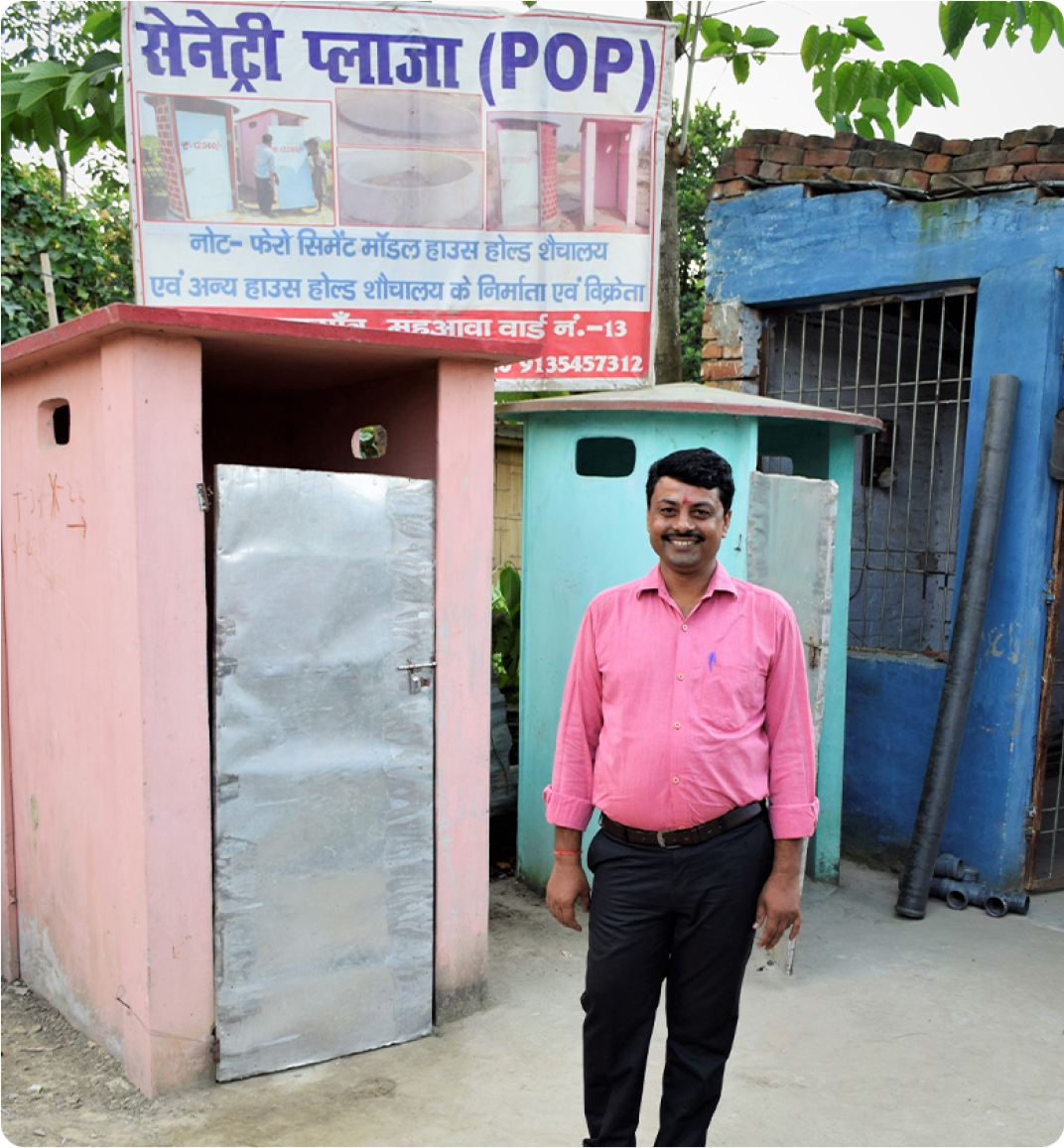
A Solution to Sanitation Gaps:
The Supply Chain & Points of Purchase in Rural India
This study was conducted by Ecociate Consultants. The full study report can be found here:
https://thewashroom.waterforpeople.org/resources/rural-sanitaton-supply-chain-gaps-opportunities-bihar-study-report/
Problem Statement
In rural India, 22.4% still practice open defecation ( JMP, 2020 ). NGOs have a hard time selling toilets, as households believe NGOs should provide toilets for free and they do not want to buy from people they do not know or trust. Building the lining of the pit was the biggest challenge that households faced, and they needed to see a tangible, sustainable solution to unlock demand for toilets, Concrete rings provided this solution, but they were too expensive for one organization to transport long distances. Small businesses located in rural communities could improve this supply chain to overcome barriers to scale and sustainability, but entrepreneurs needed to know that NGOs would not bail them out, and that the business could be profitable on its own.
background
In India, Water for people implements market system development initiatives and capacity building of local micro-enterprises to increase access to safe and reliable household toilets. We support integration of local sanitation businesses, called Points of Purchase (POPs), into supply chains, POPs manufacture and sell cement rings to line toilet pits, arrange delivery and labor for digging pits and installing the rings, support construction of toilet superstructures, and sell various sanitation products used in toilet construction.
Study Objectives
Examine whether there is any association between POP availability and toilet coverage.
Analyze district-level POP distribution and supply chain gaps to provide insights at the state level.
Understand what prevents a higher concentration of POPs at the village level to help address exclusion.
Understant the commercial viability of POPs, including their sustainability.
Explore geographic expansion opportunities for POPs in a sustainable manner.
FINDINGS
Through the national Swachh Bharat Mission, the government carried out household-level awareness generation programs to enhance toilet usage. They used various information communication technology measures to promote toilet construction. Toilet use peaked during the Mission’s campaign, and recent floods in Bihar forced communities to continue using toilets, since open defecation in submerged fields was not possible.
As part of the Mission, the government promoted construction of brick-based septic tank technology toilets. Community members had limited input in the process, and there were complaints regarding construction quality. Septic tanks were often reported to be punctured by rodents, rendering the entire toilet useless.

Commercial viability
For a toilet without a superstructure, a POP earns a profit of approximately Rs. 3,000. Manufacturing one cement ring costs Rs. 350 to 500, and a typical pit requires 9 to 12 rings. A customer pays Rs. 12,000 to 15,000 for a POP to install a toilet pit, including the labor for digging pit and installing the cement rings.
With a superstructure, POPs can expect an approximate profit of Rs. 4,500. A customer pays around Rs 20,000 to construct a toilet with a superstructure, though very few POPs venture into superstructure construction due to financing constrains.
A typical POP earns Rs. 15,000 to 25,000 per month after recurring expenses. Capital requirements for a POP vary from Rs. 50,000 to 3 Lakhs, with an average of Rs. 1 Lakh. A typical POP averages 6-10 orders per month, with few to no sales during the rainy season.
The unique selling proposition of POPs includes competitive pricing integrated services, and credit facilities for customers, POPs used low-cost promotion on and regular participation in various village-level meetings to communicate the benefits of toilet usage.
Sample POP Monthly Revenue & Costs
Representing a typical month of sales and construction of toilets without a superstructure and 2 toilets with a superstructure.
Costs of construction of one toilet without a superstructure
Amount (Rs)
Construction materials
Sanitary accessories (pan, water seal, PVC pipe, cement Jali, etc.)
1,000
Cement
320
Toilet rings (10)
4,500
Transportation
1,500
Miscellaneous
500
Construction materials sub-total
7,820
Labor charges
Mason + labor charges for pit construction
1,000
Labor charges sub-total
1,000
Material wastage (2%)
40
Total Costs
8,860
Costs of construction of one toilet without a superstructure
Amount (Rs)
Construction materials
Bricks (1,000)
4,000
Asbestos sheet for roofing (400)
800
Sand (40 ft3.)
960
Sanitary accessories (pan, water seal, PVC pipe, cement Jali, etc.)
1,000
Cement (3)
960
Gate of iron sheet (1)
1,500
Toilet rings (10)
3,500
Transportation
1,000
Miscellaneous
200
Construction materials sub-total
13,920
Labor charges
Mason + labor for pit construction
1,000
Mason + labor for superstructure construction
2,000
Labor charges sub-total
3,000
Material wastage (2%)
150
Total costs
17,070

POP AVAILABILITY AND DEMAND FOR TOILET CONSTRUCTION
POPs developed organically without any significant support from the government or other actors like financial institutions. While the Mission triggered continuous demand for toilets, it provided no impetus for the district to promote POPs or sanitation entrepreneurs.
Demand for toilets has been universal across rural areas of the district. POPs serve customers within a 20-km radius, with a typical density of 5-10 POPs evenly distributed across a block. Urban areas have a low penetration of POPs since toilets are often linked to sewage systems, and households seek services from large hardware stores.
Construction of toilet pits using cement rings was significantly more durable than pits lined with bricks. Pits lined with cement rings required less space, were faster to build, and were easier to maintain, making them cost effective in the long run.
There is clear correlation between demand for toilets with cement rings and demand for services delivered by POPs. Demand for cement rings is supplemented by services offered by POPs, including delivery, pit preparation, ring installation, and superstructure construction.
SUPPLY CHAIN GAPS
Supply linkages are haphazard and dependent on individual capacities of POP entrepreneurs. Some POPs must arrange for transportation of key materials from distant markets. Products are not standardized, quality is inconsistent, and costs (and thus prices) vary.
Inadequate financial availability from both formal and informal sources acts as a huge barrier in the growth of POP businesses. POPs were not aware of government programs that support small enterprises. Due to low investment, integration of all products and services required for full bathroom construction is not common among POPs.
There are large business and marketing knowledge gaps. POP owners often have technical expertise but are inexperienced entrepreneurs. Many were unaware of their product costs.

EXCLUSION AT THE VILLAGE LEVEL
There is very little linkage between government actors and POPs. As such, sanitation promoters, support service providers, and extension departments show little interest in supporting POPs.
The major barrier to toilet construction was household income level. Since toilet construction via POPs was not eligible for government subsidies available through the Swacch Bharat Mission, lower income families faced hurdles in constructing toilets through POPs.
There were no major caste barriers, but lack of space for digging a pit and constructing a toilet was a challenge. Lower income and landless families struggled to allot the 4 ft of land required for construction, and some elderly people were found to prefer open defecation.

GEOGRAPHIC EXPANSION
Independent growth of the POP enterprise model without support from the government or donors showcases the strength and sustainability of the model. Community members like POPs for the personalized design, location and depth of pits, materials used, and toilet size. They also trust POPs, as they believe the entrepreneurs are accessible and there to stay.
POP businesses promise to grow both vertically and horizontally, even without donor funding. POPs want to venture into additional products and some POPs have already initiated branches in other blocks or nearby districts.
To support POP entrepreneurs, it is important to build their business capacities, enhance their access to financing, and advocate for enabling policies at the government level.

So WHat?
With these insights Water For People can better support the growth of POPs by:
- Enhancing financial access by linking POPs with microfinance institutions and government loan programs, Such as MUDRA Schemes.
- Building skills of POP entrepreneurs in business administration and marketing.
- Advocating for enabling policies at the state level and decreasing the communication gap between government actors and POPs.
- Investing in technology to reduce the cost of construction and further increase profit margin.
- Advising POPs on emerging the market trends, possible target markets, and product diversification opportunities.
- Considering an exit strategy in areas where POPs have reached scale.
Study Approach
Phase 1:
- Secondary research: Including district-level demographics and sanitation indicators.
- Sample district identification & research tool development: Saran District was chosen for its representative profile and water for People has not previously intervened there.
Phase 2:
- GIS mapping & sample POP, village, and block identification: ~60 POPs were mapped in the district.
- Information collection: Focus group discussions and key informant interviews with diverse stakeholders.
Phase 3:
- Collation of information, analysis, and report writing.

